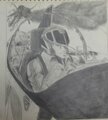-
Posts
478 -
Joined
-
Last visited
Content Type
Profiles
Forums
Events
Gallery
Everything posted by grigolosi
-

Aircraft Super Thread Mk.VII
grigolosi replied to David Hingtgen's topic in Anime or Science Fiction
The USAF block 30's had a mod performed in the early 90's called Falcon Up. They placed reinforcement brackets on the outside of the frame like the 40. They tended to leak fuel a little but they did the job. The Block 50 received the same reinforcement but they were incorporated into the internal frame so they look smooth. The Metal fatigue issues the N ran into were also found in the wing roots so the same mod wouldn't work completely. From what I have been told by some folks the Navy tended to over G them quite often even though they flew with out external tanks. That takes a lot of over G stress to cause metal fatigue in an aircraft designed for 9 g's. -

Aircraft Super Thread Mk.VII
grigolosi replied to David Hingtgen's topic in Anime or Science Fiction
Yeah they retired the first batch which were block 30 variants due to metal fatigue due to the Navy Aggressor pilots using them too "over zealously"! Unfortunately there are no F-16's nor F-35's in the video I posted. It takes A LOT of stress to cause metal fatigue in an F-16 by the way. The Block 30's were replaced with Pakistani Block 15 models that were in storage due to a weapons embargo so they were never delivered. This is the unit flying out of NAS Fallon now. Unfortunately they are the underpowered Pratt and Whimpey models and also the last Block 15 A models built. -

Aircraft Super Thread Mk.VII
grigolosi replied to David Hingtgen's topic in Anime or Science Fiction
I didn't see any....lol they must have had a new active camouflage like the predator's had. -

Real World Technical References of Macross Variable Aircraft
grigolosi replied to charger69's topic in Movies and TV Series
Just like more cowbell.................- 278 replies
-
- real world
- figther
-
(and 5 more)
Tagged with:
-

Aircraft Super Thread Mk.VII
grigolosi replied to David Hingtgen's topic in Anime or Science Fiction
I liked this video myself it was a little boring but you can't beat the taste in tail markings.......a few of you may recognize them...and there are no F-35's in this by the way... -

Aircraft Super Thread Mk.VII
grigolosi replied to David Hingtgen's topic in Anime or Science Fiction
Found this on the Facebook Crew Chief page. Interesting to look at as you see the advancements in fighter technology in the cockpit from the F-80 all the way to the F-35. http://www.odometer.com/pop-culture/38591/18-incredible-cockpit-photos-show-the-american-fighters-70-year-evolution?utm_source=ysa&utm_campaign=38591-yde3#slide/0 -

Aircraft Super Thread Mk.VII
grigolosi replied to David Hingtgen's topic in Anime or Science Fiction
i work on Al Dhafra AB here in Abu Dhabi. I see Rafales a lot since the French Armee De'la Air have a unit stationed here. That plane is compact too and not much bigger than the F-16. It is loud as hell though when it takes off. Ironically I have seen all these types flying from this base except the Gripen and the F-35. -

Aircraft Super Thread Mk.VII
grigolosi replied to David Hingtgen's topic in Anime or Science Fiction
The Gripen is only 2 feet shorter than an F-16 (1 foot for the 2 seat version) but the frame is far more compact. While I was assigned to Red Flag Alaska back from 06-09 we had a squadron of brand new JAS-39's show up for a Red Flag with the Swedish AF. The size difference between the F-16 and Gripen is very noticeable. A few of our pilots went up in a 2 seater and liked the way the 39 handled but they commented on how small the cockpit was also compared to even the F-16. -

Aircraft Super Thread Mk.VII
grigolosi replied to David Hingtgen's topic in Anime or Science Fiction
F-16's aren't as small as everyone thinks they are. Yes when compared to an F-15 or Su-27 they are, but in reality they are still larger than the both the F-5 or Gripen. The F-16 is 49 feet long and from top to bottom stands 16 feet. In actuality that would be longer and taller than a VF-1 Valkyrie. -

Aircraft Super Thread Mk.VII
grigolosi replied to David Hingtgen's topic in Anime or Science Fiction
Yup essentially they are a miniaturized F-16. The main landing gear are based on the F-16's as well. -

Aircraft Super Thread Mk.VII
grigolosi replied to David Hingtgen's topic in Anime or Science Fiction
found this article on one of the FB pages i belong to. Its a compilation of F-16 Maintenance going on with 3 different Squadrons. The 421st, 182nd, and the 36th. http://worldwarwings.com/if-you-think-servicing-an-f-16-is-easy-think-again -

Aircraft Super Thread Mk.VII
grigolosi replied to David Hingtgen's topic in Anime or Science Fiction
That is definitely a Scorpion. It makes sense with the A-10 since it is fully NV compatible and is also fully color capable and is a quick and efficient mod to the A-10. That gives the Warthog a leg up at CAS in both day and night. I would definitely agree its primary use on the A-10 is for A-G targeting and spotting. If the C models are equipped with data link units then pilots can pass target data to other aircraft in the area. As for the Tornados, I can believe that. Especially if they are flying with older NVS systems. Back in the 90's when I was stationed at Misawa, the flightline vehicles had to dim their lights during launches because the the NVS systems were too sensitive to bright lights from headlights. The aircraft were modded with internal string lights in the cockpit that had green micro bulbs to light the cockpit. -

Aircraft Super Thread Mk.VII
grigolosi replied to David Hingtgen's topic in Anime or Science Fiction
Yeah that is the JHMCS helmet currently in use.That is the power cable running down to his vest. It interconnects to a plug that is routed up from the the side console and attaches to his vest/harness. -
From the album: Untitled Album
-

Real World Technical References of Macross Variable Aircraft
grigolosi replied to charger69's topic in Movies and TV Series
The man definitely keeps up with the newest published advances in aviation technology. The wrap around cockpit was inspired by the JHMCS systems first used in the 70's and by the mainstream implementation of it in the 90's and early 2000's. I see alot of YF-23 inspiration in his work on the VF-22. In regards to the Intakes the F-105 carried one of the first Diverterless style intakes. Combined with the area rule affect on its fuselage it proved very capable of regulating airflow into the intake. The only thing missing physically is the bulged shock diverter on the fuselage side of the intake. It worked by preventing angling the intake to slow down the airflow to subsonic speeds instead of a shock cone or bulge.- 278 replies
-
- real world
- figther
-
(and 5 more)
Tagged with:
-
Well FalconPD inspired me to do this . I really don't go out of my way to share this stuff outside of Deviantart....hope you enjoy it also. Nowhere near as good as Falcons stuff though!
-
From the album: Untitled Album
Regult I drew also while in Korea -
From the album: Untitled Album
Queadlunn I drew while in Korea many yrs ago. -
From the album: Untitled Album
Roy Focker Victorious! -

Aircraft Super Thread Mk.VII
grigolosi replied to David Hingtgen's topic in Anime or Science Fiction
A lot of bases have hangar's like that. They have a separate door that closes over the tail opening when there are no heavies in for maintenance. I know Pope AFB had quite a few of them for the C-130's. -

Aircraft Super Thread Mk.VII
grigolosi replied to David Hingtgen's topic in Anime or Science Fiction
Someone ordered the super sized Sukhoi instead..... -

Aircraft Super Thread Mk.VII
grigolosi replied to David Hingtgen's topic in Anime or Science Fiction
I know this is bit off topic but I found this tonight. I thought this was just cool. The gentleman's reaction at the end of the flight is priceless. the second one is for all you VF-19 finatics. It also proves some actual real aerodynamic possibilities of the VF series. -

Does somewhat unrealistic mecha controls ruin the fun for you?
grigolosi replied to JLYC's topic in Movies and TV Series
I remember seeing that also in that episode. I do notice they don't wear any type of ejection harness, at least the type you would expect. Generally there are a set of "ball breaker" belts that loop up through the crotch area with the shoulder latches hooking to the chute in the seat. I understand the whole ejection thing in space wouldn't require the parachute but in an atmosphere they would need it. The Ex-Gear in the VF-25 eliminates the need for it but in older VF designs (pre Ex-Gear) they would still need it. Generally the pilot is attached to the newer seats with 2-3 straps or belts. The lap belt only keeps the pilot down in the seat. The shoulder straps are buckled to the ejection harness and like I said attach directly to the seat parachute. The last set are attached to the survival kit and also buckle to the harness at the sides so when deployed the kit drops and hangs below the pilot in the chute. This the harness for the ACES II seat -

Real World Technical References of Macross Variable Aircraft
grigolosi replied to charger69's topic in Movies and TV Series
That was my general interpretation also Valkyrie. Especially since the team that flies them seem to be aligned with a Eurpoean influenced Kingdom.- 278 replies
-
- real world
- figther
-
(and 5 more)
Tagged with:
-

Aircraft Super Thread Mk.VII
grigolosi replied to David Hingtgen's topic in Anime or Science Fiction
Well unlike the military production. When airliner production is cancelled, the tooling equipment is generally not destroyed. The biggest costs would be to establish a new production site and train the work force to manufacture it again, IF they even have to do that.




